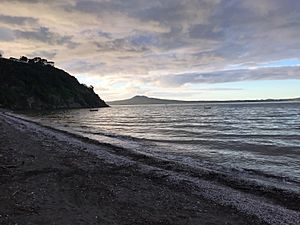Karaka Bay (Auckland) facts for kids
Karaka Bay, also called Waiarohe, means 'the bay of shimmering waters'. It's a special spot on the western side of the Tāmaki River mouth. You can find it in the Glendowie area of Auckland.
From Karaka Bay, you can see many islands in the eastern Waitematā Harbour. These include Rangitoto, Motutapu, Motukorea (Browns Island), Motuihe, and Waiheke. You can also see Musick Point across the water.
Getting to Karaka Bay is an adventure! You can arrive by boat or walk down a steep path. This path winds down from the end of Peacock Street. There are no roads leading directly to the bay. This lack of road access makes Karaka Bay feel unique and different from other places in Auckland.
Contents
History of Karaka Bay
Early Māori Life
Long ago, before Europeans arrived, the Tainui canoe is said to have landed at Karaka Bay. Some of its crew members settled there. There was once a Māori pā (a fortified village) at the top of the bay. It might have been called Taurere or Ohuirangi. Many old tools like adzes and signs of early homes have been found here. The bay gets its name from the karaka trees that were planted. These trees provided food for the pā residents.
In February 1827, a French explorer named Dumont d’Urville visited the area in his ship, the Astrolabe. Later that year, Karaka Bay was likely the site of the last battle fought in Auckland. The Ngapuhi tribe was defeated by other Māori groups.
The Treaty of Waitangi Signing
A very important event happened at Karaka Bay on 4 March 1840. The Treaty of Waitangi was signed here by 17 chiefs. Most of these chiefs were from the Ngāti Pāoa and Ngāti Maru tribes. William Hobson, a key figure in the Treaty, was not present for this first signing. He was ill on his ship nearby.
Four months later, on 9 July 1840, six more chiefs signed the Treaty at Karaka Bay. This time, Hobson was there. Captain David Rough, Auckland's first harbour master, described the scene. He said the Union Jack flag was flying, and the Treaty was on a table. Māori people in their traditional mats and canoes on the sandy beach made a beautiful picture.
Changes Over Time
Land and Development
On 28 May 1841, 24 Ngāti Pāoa chiefs sold the land, including Karaka Bay, to the Crown. This area was later part of the Glendowie land created in 1842. In 1845, John Commons and William McKenzie bought the land block that included Karaka Bay.
In 1912, a farmer named George Riddell bought the Glendowie Estate. Riddell Road, which is at the top of the bay, is named after him. By 1921, the area was divided into sections to be sold. What we now call Peacock Street was then known as Pah Road.
The first permanent building, a boat shed, was built in 1923. Later, holiday homes called baches were added in the 1920s. Over time, these holiday homes were replaced by more permanent houses.
Fun Facts and Events
The Escaped Leopard!
In 1925, something very unusual happened! A 6-foot-long leopard had escaped from the Auckland Zoo. Three weeks later, a group fishing in Karaka Bay found it dead in the Tāmaki River.
The Famous Piglet
In 1997, Karaka Bay became famous for a very special resident: a large white pig named Piglet! Piglet was born far away in Hokianga. She came to Karaka Bay with some students. Piglet was loved by many people and charmed all the local children. She even got attention from news channels around the world! The BBC sent a film crew from London to see her. People from all over came to Karaka Bay just to meet Piglet or even swim with her. Piglet eventually returned to Hokianga. Her owner, Tony Watkins, later wrote a children's book about her called Piglet the Great of Karaka Bay.
Recent Discoveries and Commemorations
In 1953, a drinking fountain and seat were put up near the path. This was to remember the Treaty signing. The plaque was stolen in 2010, but a new one was put in its place. Also in 1953, heavy rain caused a big landslide. It brought down a newly built house on Peacock Street.
On 1 December 2012, representatives from Ngāti Pāoa signed an important agreement called the Tāmaki Makaurau Collective Redress Deed at Karaka Bay. On 4 March 2015, the Ngāti Pāoa Iwi Trust held an event to celebrate 175 years since the Treaty of Waitangi was signed. In 2018, some children found parts of a wrecked boat. A family used to sleep in this boat around 1925!


